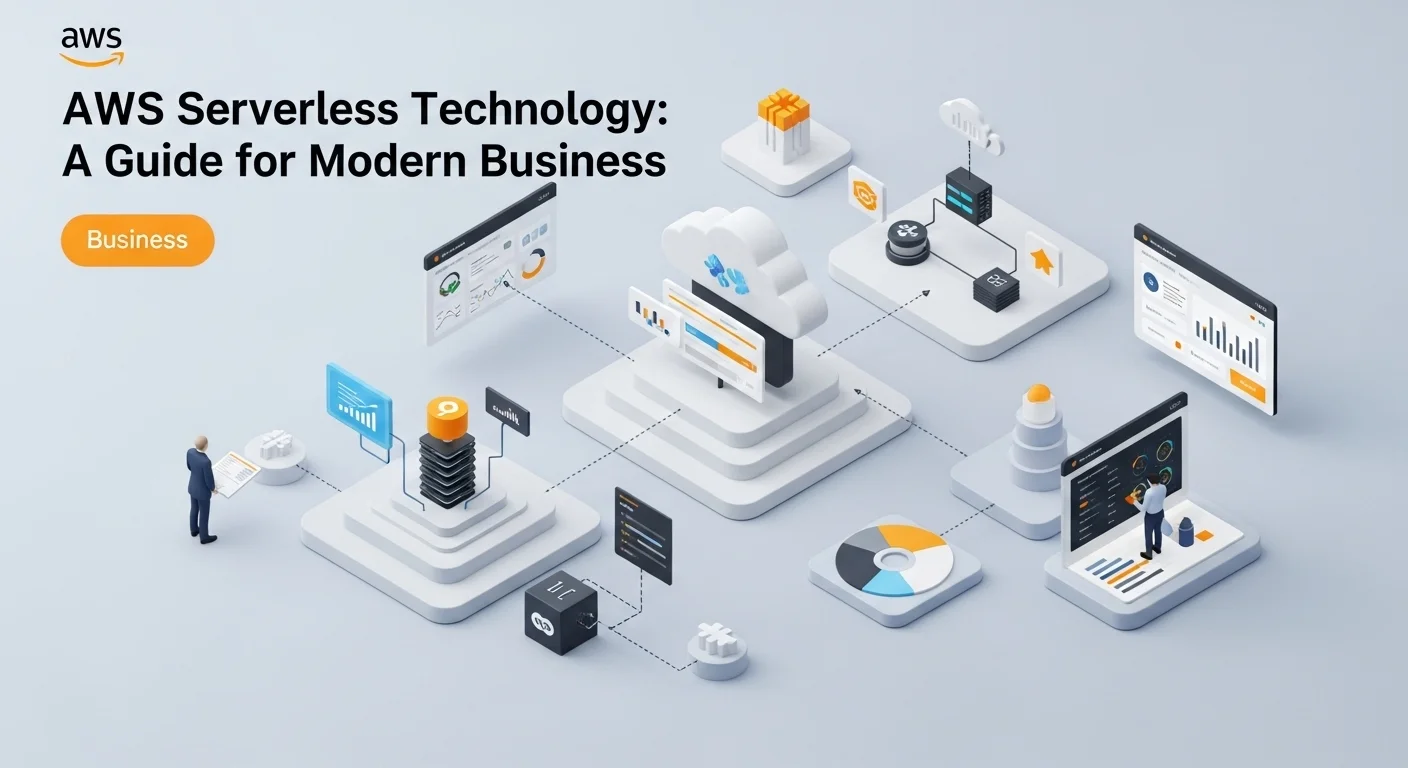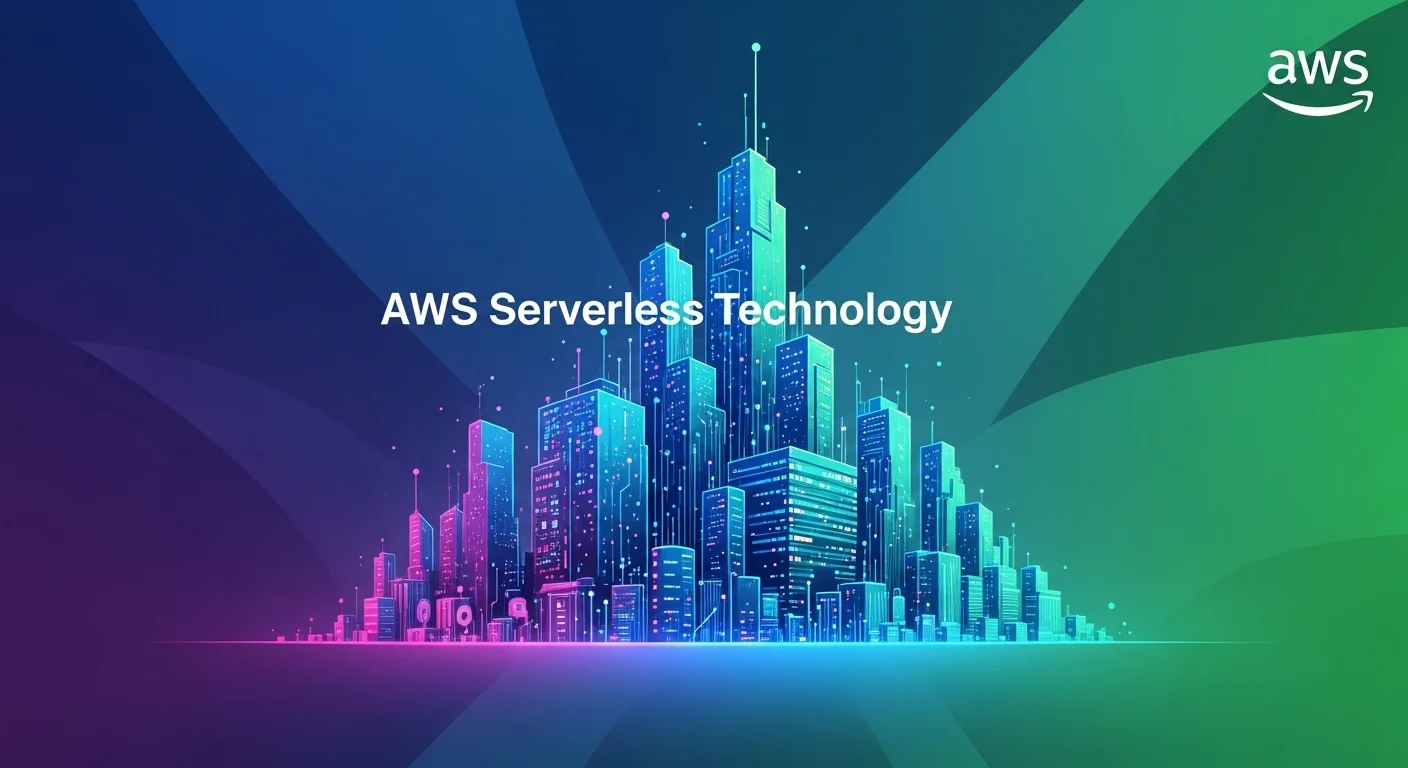From Idea to Scale: A Practical Guide to AWS Serverless for Your Business

Executive Summary
Let's talk about one of the biggest game-changers I've seen in my career: AWS Serverless. If you're tired of the constant headache of managing servers and want to focus on what truly matters—building amazing products—then you've come to the right place. Think of this article as your personal guide to understanding serverless, not as some complex tech buzzword, but as a powerful, practical tool for your business. We'll break down the core ideas in simple terms, explore key services like AWS Lambda and DynamoDB, and show you how this approach can dramatically cut your costs and boost your team's speed. Whether you're leading a team or writing the code, my goal is to help you navigate the serverless world and start building more resilient, efficient solutions for the future.
Table of Contents
Table of Contents
What is AWS Serverless and Why Does It Matter?
In the world of technology, we're always looking for a smarter way to work. For me, one of the biggest 'aha!' moments was my first encounter with AWS Serverless. So, what is it? The name 'serverless' is a bit misleading. Of course, there are still servers involved! The magic is that you don't have to think about them. Ever. Think of it like this: instead of building a whole restaurant kitchen just to make a pizza, you simply order one and it arrives hot and ready. Serverless is the pizza delivery of the cloud. AWS manages all the infrastructure—the provisioning, patching, and scaling—so your team can pour all their energy into writing code that solves real customer problems. It's a fundamental shift from worrying about hardware to focusing purely on innovation.
This is so important because it changes the entire dynamic of building and launching an application. I remember the old days of carefully planning server capacity, dealing with late-night server crashes, and spending weekends applying security patches. It was a massive drain on time and resources. With a serverless approach, that entire layer of stress and complexity just vanishes. You write your code in small, independent functions. These functions spring to life only when they're needed, triggered by an event—like a user clicking a button on your app, uploading a photo, or a new entry appearing in your database. This event-driven model is the engine behind the incredible efficiency and scalability of serverless.
The Guiding Principles of Serverless
To really get why this is such a big deal, let's break down the core ideas that set it apart from traditional hosting.
- No Server Management: This is the big one. You never see a server, you never patch an operating system, and you never worry about hardware. AWS handles it all. This frees up your most valuable resource: your developers' time.
- Event-Driven & Stateless: Serverless functions are like tiny, focused workers that are called upon to do one specific job when an event happens. They don't hold onto memory or data from one job to the next. Any information they need to 'remember' is stored in an external database or cache.
- Pay for What You Use: This is where the business case really shines. Instead of paying for a server to be running 24/7, you pay only for the compute time your code is actually running, down to the millisecond. If nobody is using your app, your bill can be literally zero. It’s the ultimate pay-per-value model.
- Automatic Scaling: Remember planning for 'peak traffic'? With serverless, that's a thing of the past. If one person uses your app, one function runs. If a marketing campaign brings 100,000 users at once, AWS automatically scales to handle every single request without you lifting a finger. That elasticity is built-in.
Key AWS Serverless Services You Should Know
AWS provides a whole toolkit of services that work together to create a serverless application. Here are the main players you'll get to know.
AWS Lambda: This is the heart and soul of AWS serverless. It's the service that runs your code. You can write your functions in languages your team already loves, like Python, Node.js, or Java. Lambda takes your code, runs it whenever it's triggered, and handles all the scaling. It's the workhorse that executes your business logic.
Amazon API Gateway: If Lambda is the heart, API Gateway is the front door. For any web app, it's the secure and managed entry point for all your backend services. It takes incoming requests from your users, handles things like security and traffic control, and then directs them to the right Lambda function. It's what turns your functions into a real, usable API.
Amazon S3 (Simple Storage Service): While S3 can do many things, in the serverless world, it's a vital partner. It's the perfect place to store static website files (like HTML and CSS) or user-uploaded content. For example, you can set it up so that every time a user uploads a new profile picture to S3, it automatically triggers a Lambda function to create a thumbnail.
Amazon DynamoDB: Since your Lambda functions are stateless, they need a fast, reliable place to store and retrieve data. DynamoDB is a database built for the serverless era. It's incredibly fast, scales seamlessly, and its pay-per-request pricing model is a perfect match for Lambda's. It's the brain's memory for your application.
AWS Step Functions: A single function is great for a simple task, but what about a multi-step process like handling an e-commerce order? That's where Step Functions comes in. It lets you visually coordinate multiple Lambda functions and other services into a robust workflow, making it easy to build and manage complex processes.
Real-World Business Impact and Benefits
The tech is cool, but the business results are what truly matter. Adopting a serverless model brings tangible benefits that any leader can appreciate.
First is the incredible cost optimization. By eliminating idle server costs, I've seen companies slash their infrastructure bills, especially for new projects or apps with unpredictable traffic. You're not just saving on servers; you're saving on the operational staff hours needed to manage them.
Second is the boost in agility and speed of innovation. When your developers aren't bogged down with infrastructure tasks, they can focus on shipping features that customers love. The time it takes to go from a new idea to a deployed feature can shrink from weeks to days, or even hours. This lets you outpace the competition.
Finally, you get scalability and reliability baked right in. Your application inherits the world-class infrastructure of AWS. You don't have to worry about your site crashing during a Super Bowl ad or a viral social media post. AWS handles the traffic spikes transparently, ensuring your customers always have a smooth experience. In my experience, this peace of mind is one of the most underrated benefits of going serverless.

Building a Serverless App: A Practical Walkthrough
So, how do all these pieces actually come together? Let's walk through a common example: building a dynamic web application. Thinking about it this way helped me move from theory to practice.
- The Frontend: First, you have the part the user sees. This is often a modern web app built with a framework like React or Vue.js. All the static files—the HTML, CSS, and JavaScript—are stored in an Amazon S3 bucket. We then put Amazon CloudFront in front of it, which acts as a global CDN. This makes the site load lightning-fast for users anywhere in the world and secures it with HTTPS.
- The API 'Front Door': When a user does something, like submitting a contact form, the frontend app needs to talk to the backend. This is where Amazon API Gateway comes in. We create API endpoints, like `POST /contact-form`, which act as the secure entry point for our backend. API Gateway handles the initial request and knows exactly where to send it.
- The Brains (Business Logic): This is where AWS Lambda takes center stage. Each API endpoint is connected to a specific Lambda function. So, that `POST /contact-form` request triggers our `handleContactForm` function. This is where our Python or Node.js code lives. The code validates the user's input, processes it, and maybe sends an email notification. The beauty here is that each function is small and focused on a single task, which makes our code much easier to manage and update.
- The Memory (Data Storage): Our Lambda function needs to save the form submission somewhere. This is the perfect job for Amazon DynamoDB. Our `handleContactForm` function writes the data to a 'Submissions' table in DynamoDB. Because DynamoDB is so fast and scales automatically, we never have to worry about our database becoming a bottleneck.
- Connecting the Dots: For more complex processes, like a full e-commerce checkout, we might use AWS Step Functions to orchestrate a series of Lambda functions in the right order. For other tasks, like sending a welcome email after signup, we can use services like Amazon SQS (a message queue) to decouple our services. The signup function simply drops a message into a queue, and another, separate Lambda function picks it up to handle the email. This makes the whole system incredibly resilient.
What is AWS SAM? Your Serverless Toolkit
Defining all of this manually in the AWS console is fine for learning, but it doesn't scale for real projects. That's where Infrastructure as Code (IaC) becomes your best friend. The AWS Serverless Application Model (SAM) is a framework designed specifically for this. Using a simple YAML file, you can define your entire application—your functions, APIs, databases, and all the connections between them. The SAM command-line tool (CLI) then lets you build, test, and deploy your entire stack with a single command. This has been a lifesaver for my teams, making our deployments repeatable, reliable, and incredibly fast.
Serverless vs. Containers vs. VMs: Choosing the Right Tool
It's helpful to know where serverless fits in the broader landscape. It's not about which one is 'best,' but which is the right tool for the job.
- Virtual Machines (EC2): The classic approach. You get a full virtual server with total control, but also total responsibility for patching, security, and scaling. You pay for it as long as it's on. Best for legacy apps or when you need deep control over the environment.
- Containers (Docker/Kubernetes): A great middle ground. You package your app and its dependencies together for consistency. It's more efficient than VMs, but you often still need to manage a cluster of servers to run the containers. It gives you portability and control over the software stack without managing the OS.
- Serverless (Lambda): The highest level of abstraction. You only manage your code. AWS handles everything else. The cost model is the most efficient, tied directly to usage. It's the fastest way to build and scale for event-driven applications, but you trade some control for that convenience.
In many modern systems I build, we use a mix. We might use serverless for our user-facing APIs and event processing, while a long-running data analytics job might live in a container. It's all about using the strengths of each model.
Bringing Serverless into Your Business
Making the switch to serverless is a journey. My advice is always to start smart.
- Start Small: Don't try to rewrite your entire platform at once. Pick a good pilot project—a new feature, an internal tool, or a single part of an older application that needs modernizing. This lets your team learn in a low-risk environment.
- Find Event-Driven Wins: Serverless excels at reacting to events. Look for opportunities like processing new file uploads, handling IoT data streams, or integrating with third-party webhooks. These are often easy and high-impact first projects.
- Invest in Your Team: This is a new way of thinking. Give your developers time and resources to learn about Lambda, API Gateway, DynamoDB, and SAM. When the team is confident, the magic really starts to happen.
- Think Security First: In serverless, security shifts from the network edge to the individual function. It's critical to adopt a 'least privilege' mindset, giving each function only the exact permissions it needs to do its job.
By following this roadmap, you can thoughtfully integrate serverless into your organization and begin building faster, more resilient, and more cost-effective applications that truly drive your business forward.

Tips and Strategies to Master AWS Serverless
Once you've got your first serverless application running, the real fun begins. Now it's about refining your craft—making your applications faster, cheaper, and more reliable. Here are some of the key strategies and hard-won lessons I've learned over the years to help you level up your serverless game.
Boosting AWS Lambda Performance
A common topic that comes up is Lambda performance, specifically something called a 'cold start'.
Tackling Cold Starts: A cold start happens the first time a function is invoked after a period of inactivity. AWS has to set up a new environment for your code, which adds a bit of latency. For most applications this is trivial, but for a user-facing API, every millisecond counts. Here's how to manage it:
- Choose the Right Language: In my experience, interpreted languages like Node.js and Python tend to have faster startup times than compiled languages like Java or .NET, simply because their runtimes are lighter.
- Keep Your Code Lean: The smaller your deployment package, the faster Lambda can start it up. Be ruthless about your dependencies. Only include what you absolutely need. Tools that 'tree-shake' your code to remove unused parts are a huge help.
- Right-Size Your Memory: In Lambda, memory allocation also determines CPU power. Bumping up the memory for a function can actually make it run faster and, sometimes, even cheaper if the execution time drops enough. Always test different memory settings to find that performance-to-cost sweet spot.
- Use Provisioned Concurrency: If you have a critical function that absolutely cannot have a cold start, you can pay to keep a certain number of instances 'warm' and ready to go with Provisioned Concurrency. This guarantees near-instant response times for a predictable cost.
The Art of Observability: Seeing Inside Your App
With your application distributed across many small functions, you need great visibility to understand what's going on. This is what we call observability—the ability to ask any question about your system's state.
- Amazon CloudWatch is Your Foundation: By default, everything your Lambda function logs goes straight to CloudWatch Logs. Get comfortable using CloudWatch Logs Insights to query this data. You can also create custom metrics and alarms to get notified proactively if error rates spike or performance degrades.
- Trace with AWS X-Ray: This tool is a lifesaver for debugging. When a user request flows through API Gateway to Lambda and then to DynamoDB, X-Ray traces the entire journey. It creates a visual map showing you exactly where time is being spent, making it easy to hunt down bottlenecks in your system.
- Log with Structure: Don't just log plain text strings. Log your messages as structured JSON objects. Include context like a `requestId` or `userId` in every log message. This makes searching and filtering your logs infinitely more powerful and allows you to trace a single user's activity through the entire system.
- Consider Third-Party Tools: While AWS tools are great, there are amazing third-party platforms that specialize in serverless observability. They can often provide even deeper insights and more user-friendly dashboards to help you monitor your application health.
Automating Your Workflow with DevOps and CI/CD
To truly unlock the agility of serverless, you need to automate your deployment process. A solid Continuous Integration and Continuous Deployment (CI/CD) pipeline is non-negotiable for any serious serverless project.
A typical pipeline for a serverless app looks like this:
- Commit: A developer pushes code to a Git repository like GitHub.
- Build & Test: This automatically triggers a process (using a tool like AWS CodePipeline or Jenkins) that builds the application and runs a suite of automated tests to catch any bugs.
- Deploy to Staging: If the tests pass, the pipeline automatically deploys the new version to a staging environment that mirrors production. Here, you can run more tests to ensure everything works together.
- Deploy to Production: After a final approval (which can also be automated), the pipeline safely deploys the changes to your users. You can even use advanced techniques like canary deployments to release the change to a small percentage of users first.
This automation removes human error and gives your team the confidence to release updates multiple times a day.
Quality External Resource
When you're ready to explore even more advanced patterns, my go-to recommendation is always the official AWS Serverless homepage and its blog. It's constantly updated by the experts at AWS and is the best place to find reference architectures and deep-dive tutorials.
Final Thoughts
As you grow with serverless, remember to keep an eye on your spending with tools like AWS Cost Explorer. Tagging your resources is crucial for understanding which project is costing what. And never stop learning and refining. By applying these strategies, you can move from simply using serverless to truly mastering it, building technology that is not just innovative but incredibly efficient, reliable, and secure.
Expert Reviews & Testimonials
Sarah Johnson, Business Owner ⭐⭐⭐
This was a helpful introduction to AWS Serverless. I grasp the cost-saving benefits now, but I'd love to see a simple case study of a small business, like mine, putting this into practice.
Mike Chen, IT Consultant ⭐⭐⭐⭐
A really solid overview. I've worked with AWS before, and this article connected a lot of dots for me on the serverless side. The comparison with containers was particularly clear and useful for my client discussions.
Emma Davis, Tech Expert ⭐⭐⭐⭐⭐
Fantastic article! As a developer diving deeper into serverless, this was incredibly well-written and comprehensive. The tips on performance and observability in Part 3 are gold. Thank you!



